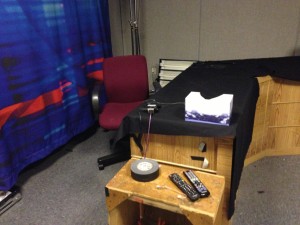Yesterday’s release of the Case Shiller Index prompted a flurry of coverage given the 20-cities’ highest YoY increase in 7-years. I did a three way split interview from a remote location in CT (see studio set up below). I was a guest along with Vincent Reinhart, chief US economist at Morgan Stanley and Stan Humphries, chief economist at Zillow Inc. Betty Liu and Adam Johnson kept the conversation going.
I especially liked Stan’s modification of the Case Shiller Index results which excluded foreclosures and his research on low and negative equity (my explanation for low inventory right now). The drop in foreclosure activity over the past year caused significant skew to the mix. According to Stan the index would show roughly a 5% increase YoY rather than an 10.9% increase. A huge difference and yet another reason why this index does more harm than good to our understanding of the housing market.
Vincent’s observation that seasonality is considered in Case Shiller is basically wrong – not technically wrong because the data is seasonally adjusted. However the methodology of a repeat sales index washes out seasonality. If you look at the Case Shiller chart, there hasn’t been “seasons” in housing since 1987. That’s simply not true. The Case Shiller Index does not reflect annual housing cycles.
Since Case Shiller Index lags the signing of contracts by 5-7 months, expect to see much higher YoY results this summer.
How the sausage is made
Bloomberg TV is always great to work with – they arranged for me to use a remote studio in CT through a third party. Here is what the studio looks like. Amazingly primitive but it works!



